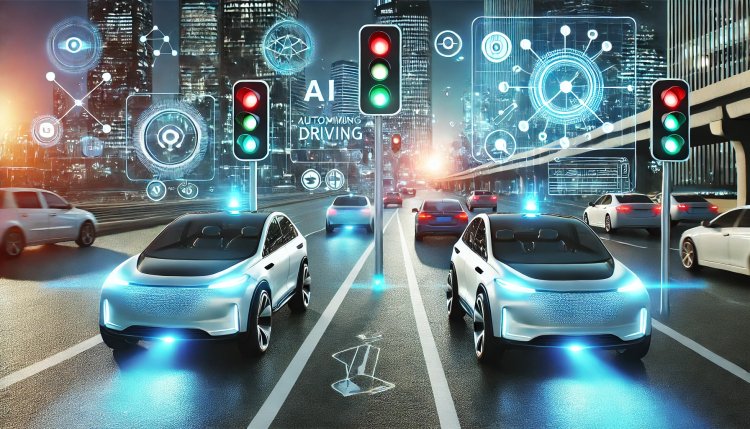How Self-Driving Cars Are Changing the Future of Transportation

Introduction
The concept of self-driving cars, once a dream of science fiction, is now becoming a reality. Autonomous vehicles (AVs) are being tested and deployed worldwide, promising a future where transportation is safer, more efficient, and more accessible. But how exactly will self-driving cars reshape the way we travel? In this blog, we will explore the impact of autonomous vehicles on transportation, safety, economy, and daily life.
The Evolution of Self-Driving Cars
The journey toward self-driving cars has been long and innovative. It began with early cruise control systems in the 1950s, advanced to driver-assist features like automatic braking and lane-keeping in the 2000s, and is now reaching the level of fully autonomous driving. Companies like Tesla, Waymo, Uber, and Apple are at the forefront of this revolution, conducting extensive research and real-world testing.
Autonomous vehicles operate using a combination of AI (Artificial Intelligence), LiDAR (Light Detection and Ranging), GPS, radar, and cameras to detect obstacles, traffic, and pedestrians. The goal is to create a system that can drive as safely—if not safer—than humans.
How Self-Driving Cars Will Transform Transportation
1. Enhanced Road Safety
One of the biggest advantages of self-driving cars is their potential to reduce accidents caused by human error. According to the World Health Organization (WHO), over 1.3 million people die annually in road accidents, with 94% of crashes attributed to human mistakes such as speeding, distraction, and fatigue.
Autonomous vehicles, unlike human drivers, don’t get distracted, tired, or drunk. They follow traffic rules strictly and react faster to potential hazards, significantly lowering accident rates.
2. Reduced Traffic Congestion
Traffic jams are a global problem, wasting fuel and time. Self-driving cars use real-time data and AI to optimize routes, reducing unnecessary stops and slowdowns. This can lead to smoother traffic flow and less time spent commuting.
Additionally, platooning—where autonomous vehicles communicate and move in synchronized formations—can further reduce congestion and fuel consumption.
3. Increased Mobility for Everyone
Self-driving cars have the potential to revolutionize transportation for disabled individuals, the elderly, and people without driving skills. Many people with physical limitations depend on public transport or caregivers for mobility, but with AVs, they could travel independently, enhancing their quality of life.
For instance, blind individuals could commute safely, and senior citizens who are no longer fit to drive could regain their freedom without relying on others.
4. Cost Savings and Ride-Sharing
Autonomous taxis and ride-sharing services will change the way we think about car ownership. Instead of owning a car, people might prefer to subscribe to on-demand self-driving taxis like Waymo’s robotaxi service.
This shift will lead to:
✅ Lower car ownership costs (no need to buy, maintain, or insure a vehicle).
✅ Reduced parking problems, as self-driving cars could be used continuously instead of sitting idle.
✅ Cheaper ride-sharing fares, as autonomous taxis will have lower operational costs compared to human-driven taxis.
5. Environmental Impact
Self-driving cars are expected to be predominantly electric, which will reduce carbon emissions. When combined with AI-driven efficient driving techniques (such as avoiding unnecessary acceleration or braking), these vehicles can reduce overall fuel consumption and help combat climate change.
Governments worldwide are also encouraging the shift to self-driving electric vehicles through incentives, aiming to create greener cities with fewer emissions.
Challenges Facing Self-Driving Cars
Despite their potential, self-driving cars still face several challenges:
1. Legal and Ethical Concerns
Governments and lawmakers need to create clear regulations on liability and accident responsibility. If an autonomous car crashes, who is responsible—the car manufacturer, the AI software developer, or the passenger?
2. Cybersecurity Risks
Since self-driving cars rely on AI and cloud connectivity, they are vulnerable to hacking. A cyberattack could cause AVs to malfunction, leading to potential disasters.
3. Job Displacement
Millions of jobs in the taxi, truck driving, and delivery sectors might be affected as autonomous vehicles replace human drivers. The transition will require governments to create new job opportunities in related fields like AV maintenance, AI development, and cybersecurity.
4. Public Trust and Adoption
Many people are still skeptical about giving full control to a machine. Trust in AI-driven vehicles needs to be built gradually through safety improvements and real-world testing.
Conclusion: The Road Ahead
Self-driving cars are not just a futuristic dream; they are actively shaping the future of transportation. While challenges remain, the benefits of enhanced safety, reduced traffic congestion, cost savings, and improved accessibility make autonomous vehicles a promising innovation.
With continued technological advancements and regulatory support, we are moving toward a world where self-driving cars become an everyday reality—making transportation safer, smarter, and more efficient.
What's Your Reaction?














